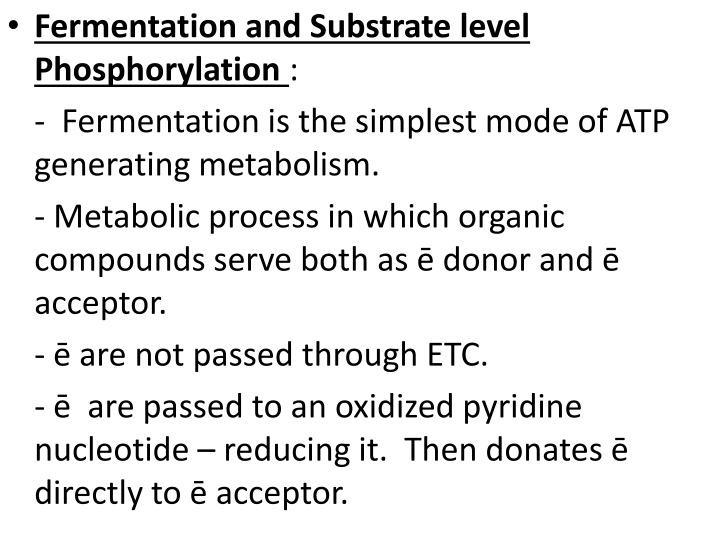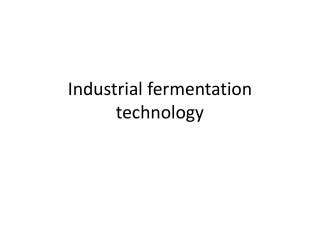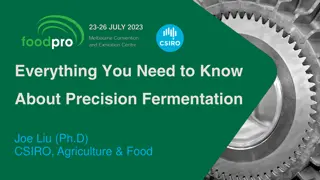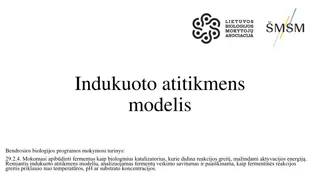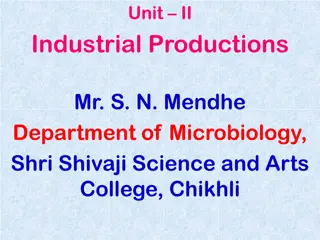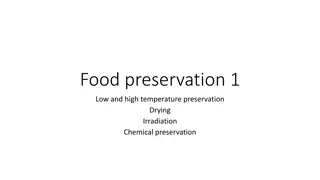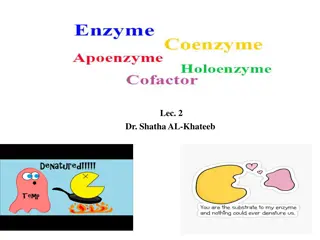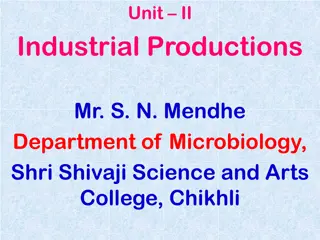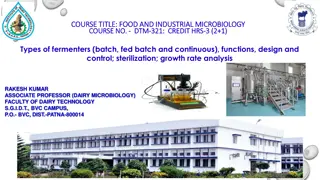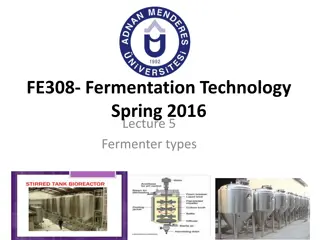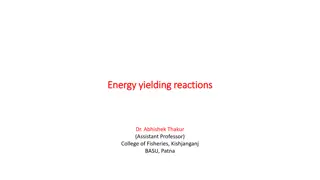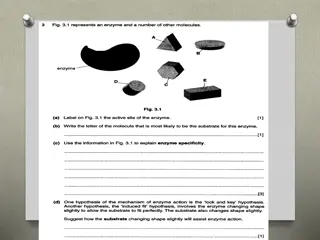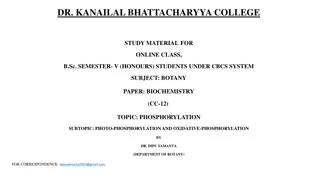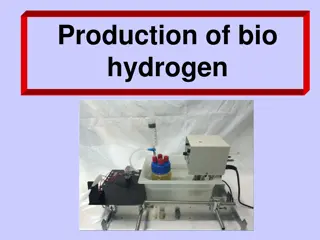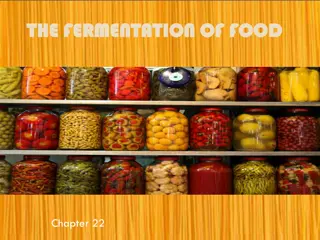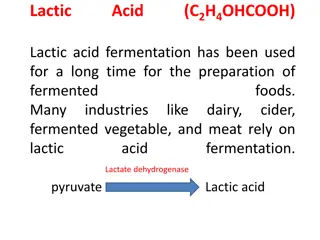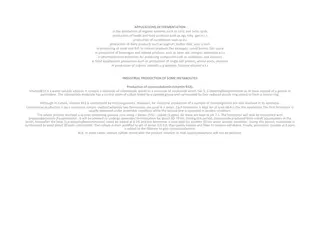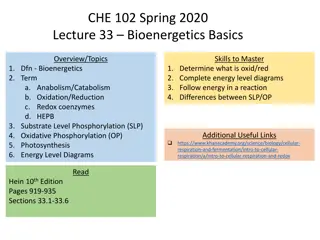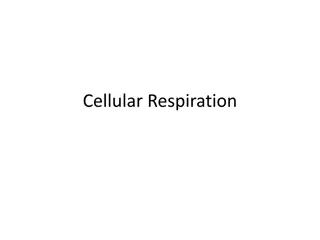• Fermentation and Substrate-level Phosphorylation
Fermentation and Photosynthesis are fundamental metabolic processes in biology. Fermentation is a simple ATP-generating metabolism where organic compounds serve as both donors and acceptors. On the other hand, Photosynthesis is the process by which plants and certain bacteria convert light energy into metabolic energy. This overview delves into the key concepts, reactions, and structures involved in both processes, offering insights into how organisms generate energy through different pathways.
Download Presentation

Please find below an Image/Link to download the presentation.
The content on the website is provided AS IS for your information and personal use only. It may not be sold, licensed, or shared on other websites without obtaining consent from the author.If you encounter any issues during the download, it is possible that the publisher has removed the file from their server.
You are allowed to download the files provided on this website for personal or commercial use, subject to the condition that they are used lawfully. All files are the property of their respective owners.
The content on the website is provided AS IS for your information and personal use only. It may not be sold, licensed, or shared on other websites without obtaining consent from the author.
E N D
Presentation Transcript
Fermentation and Substrate level Phosphorylation : - Fermentation is the simplest mode of ATP generating metabolism. - Metabolic process in which organic compounds serve both as donor and acceptor. - are not passed through ETC. - are passed to an oxidized pyridine nucleotide reducing it. Then donates directly to acceptor.
- organic compounds that serve both as donor and acceptor are usually two different metabolites derived from a single substrate. - Fermentation often gives rise to a mixture of end products some may be more reduced and some may be more oxidized than the primary substrate. - Carbohydrates are the principle substrate of fermentation.
- ATP is formed from ADP & Pi from phosphorylated intermediate arise during substrate breakdown is only possible with fermentation is known as substrate level phosphorylation. - Organisms that obtain energy by fermentation are strict anaerobes. - Pyridine nucleotides reduced in one step of fermentation are oxidized in another. - Two molecules of NAD reduced are reoxidized by reactions involving the subsequent metabolism of pyruvic acid. Fig :
Photosynthesis & Photophosphorylation Photosynthesis is the process by which plants & certain bacteria (Phototrophs) converts radiant (light) energy in to metabolic energy & reducing power. Photosynthetic structure in plant Chloroplast. In bacteria- chromatophore. General equation for photosynthesis : CO2 + H2O O2 + (CH2O) In plants it is H2O , in bacteria H2S or organic compounds.
Different types of reactions in Bacterial Photosynthesis: - Purple Sulphur Bacteria e.g. Chromatium utilize H2S. 2H2S + CO2 C(H2O) + 2S + H2O - Purple Sulphur Bacteria utilize Thiosulphate as reductant. 2CO2 + Na2S2O3 + 5H2O 2C(H2O) + 2H2O + 2NaHSO4 - Non sulphur bacteria e.g.- Rhodosprillum rubrum utilizes organic compounds like ethanol, isopropanol or succinate. CO2 + 3 C2H5OH 2C(H2O) + H2O + CH3CHO - Purple and green sulphur bacteria carry out anoxygenic photosynthesis.
Photosynthetic Appratus Consist of Three components: 1. An antenna of light harvesting pigments. 2. A photosynthetic Reaction Centre 3. ETC I. An antenna of light harvesting pigments : Light harvesting pigments include : Chlorophylls, Carotenoids, Phycobiliproteins.
- Chlorophylls- Plays two roles in photosynthesis - as a light harvesting pigment and as light harvesting pigment. - Carotenoids & Phycobiliproteins function only as light harvesting pigment. Chlorophylls : - Seven kinds occur in various groups of Phototroph. - Absorb light intensity in two regions Violet around 400 nm and red or infrared around 600 to 1000nm. - Resemble hemes.
- Contain four pyrrole ring which are linked to gather by methane bridge. - In bacteria - chlorophylls are Bacteriochlorophylls - a, b, c, & d. Also contain small amounts of Pheophytins or Bacteriopheophytins(BChl that lack Mg ). - play a special role as carriers.
Carotenoids : - Found in almost all photosynthetic organisms. - Yellow and orange pigment- soluble inorganic solvents. - Two types Carotenes & Carotenols. Carotenes e.g. carotene , are hydrocarbon. - present in photosystem- I. Carotenols (Xanthophylls) are alcohols. Present in photosystem II. - Carotenods have single region of absorption between 450 & 550 nm.
Phycobiliproteins : - are water soluble chromoproteins, contain tetrapyrrols. - Region of absorption is between 550 & 650 nm. - two kinds Phycocyanins (predominate in Blue Green Bacteria)& Phycoerythrins(Red algae). II. Photochemical Reaction Center : - contains the site where a molecule of chlorophyll becomes photoactivated & oxidized by donating to a carrier molecule.
- Chlorophyll molecule of reaction center differ from antenna (1) They are associated with certain proteins which on interaction decreases the energy required for activation. (2) They are in close proximity with carrier molecule which accept from them when activated. - Energy required to activate a molecule of chlorophyll is designated as P (pigment) in reaction center, by a maximum wavelength of photon.
e.g. the reaction center of purple bacterium that is activated maximally by photons of wavelength 870 nm is designated P870. Reaction center of Purple bacterium- Rhodobacter sphaeroides , -- contains three polypeptide chain, four bacterioChl. , two bacteriopheophytin , two ubiquinone and one iron molecule. - Rhodopseudomonas viridis also contains cytochrome subunit with four C type hemes.
III. Photosynthetic ETC : Photosynthetic ETC located within Photosynthetic membrane composed of carrier molecules - cytochromes, quinones and Iron sulfur centers. - Electron flows through ETC a proton motive force is generated- used to synthesize ATP by a membrane located ATPsynthase. ETC : Hemes in cytochrome subunit of RC P870 BChl BP QA QB Cyt- bc1 Cyt- C2 ---------- ----------- ----------- ---------- --------- ------ ---------
Photophosphorylation : - Photosynthetic bacteria have relatively simple phototransduction machinery, with one of two general types of reaction center. - One type (found in purple bacteria) passes electrons through pheophytin (chlorophyll lacking the central Mg2 ion) to a quinone. - The other (in green sulfur bacteria) passes electrons through a quinone to an iron-sulfur center.
- The photosynthetic machinery in purple bacteria consists of three basic modules (Fig. ) : a single reaction center (P870), a cytochrome bc1 electron transfer complex , and an ATP synthase, similar to that of mitochondria.
A pair of bacteriochlorophylls designated (Chl)2 is the site of the initial photochemistry in the bacterial reaction center. - Energy from a photon absorbed by one of the many antenna chlorophyll molecules surrounding the reaction center reaches (Chl)2 by exciton transfer. - the energy of the photon, converting the special pair to a very strong electron donor.
- The (Chl)2 donates an electron that passes through a neighboring chlorophyll monomer to pheophytin (Pheo). (Chl)2 + 1 exciton (Chl)2* (excitation) (Chl)2* + Pheo (Chl)2 + Pheo (charge separation) - The pheophytin radical now passes its electron to a tightly bound molecule of quinone (QA), converting it to a semiquinone radical
- which immediately donates its extra electron to a second, loosely bound quinone (QB) convert QB to its fully reduced form, QBH2. 2 Pheo + 2H + QB 2 Pheo + QBH2 (quinone reduction) - The hydroquinone (QBH2), carrying some of the energy of the photons that excited P870, enters the pool of reduced quinone (QH2) to cytochrome bc1 complex.
- cytochrome bc1 complex using the energy of electron transfer to pump protons across the membrane, producing a protonmotive force. - Electrons move from the cytochrome bc1 complex to P870 via a soluble cytochrome -c2. - The electron transfer process completes the cycle, returning the reaction center to its unbleached state, ready to absorb another exciton from antenna chlorophyll.
Photosynthesis in green sulfur bacteria involves the same three modules as in purple bacteria. - The process differs with respects to additional enzymatic reactions (Fig). - Excitation causes an electron to move from the reaction center to the cytochrome bc1 complex via a quinone carrier. - Electron transfer through this complex powers proton transport and creates the proton-motive force used for ATP synthesis, just as in purple bacteria.
- in contrast to the cyclic flow of electrons , some electrons flow from the reaction center to an iron-sulfur protein, ferredoxin, which then passes electrons via ferredoxin:NAD reductase to NAD, producing NADH. - The electrons taken from the reaction center to reduce NAD are replaced by the oxidation of H2S to elemental S, then to SO4, in the reaction that defines the green sulfur bacteria.
ATP : Structure, Generation & Role :- - ATP was discovered in muscle extracts by C.Fiske & Y. Subbarow in USA and independently by K. Lohmann in Germany in 1929. - The structure of ATP was first deduced by K. Lohmann in 1930.
-Derivative of nucleotide Adenosine Mono Phosphate (AMP) or Adenylic acid, to which two additional phosphate groups are linked through pyrophosphate bonds. - these two bonds are energy rich and their removal by hydrolysis yield ADP & AMP- liberates energy by the transfer of one or both terminal phosphate groups.
e.g. Activation of Glucose : Glucose + ATP Glucose-6-P + ADP Activation of Amino acids : Amino acid + ATP AMP- Amino acid + P - P - AMP is converted to ADP through energy transfer by enzymatic reaction- AMP + ATP 2 ADP - Carrier of free energy is ATP plays a central role in the transfer of free energy from exergonic to the endergonic (energy requiring) processes in the cell.
Generation of ATP : Three Mechanisms : 1. Oxidative Phosphorylation 2. Substrate level Phosphorylation 3. PhotoPhosphorylation Role of ATP : - Fritz Lipmann- 1941 postulated that - ATP functions in a cyclic manner from degradative reactions which yield energy to the various cellular processes that require energy.
- Drive the entry of nutrients into the cell. - To convert these nutrients into intermediary metabolites. e.g. amino acids, sugar- P ,nucleotides, fatty acids. - Polymerization of intermediates into biopolymers like Proteins, Polysaccharides, N. acids & lipids.
